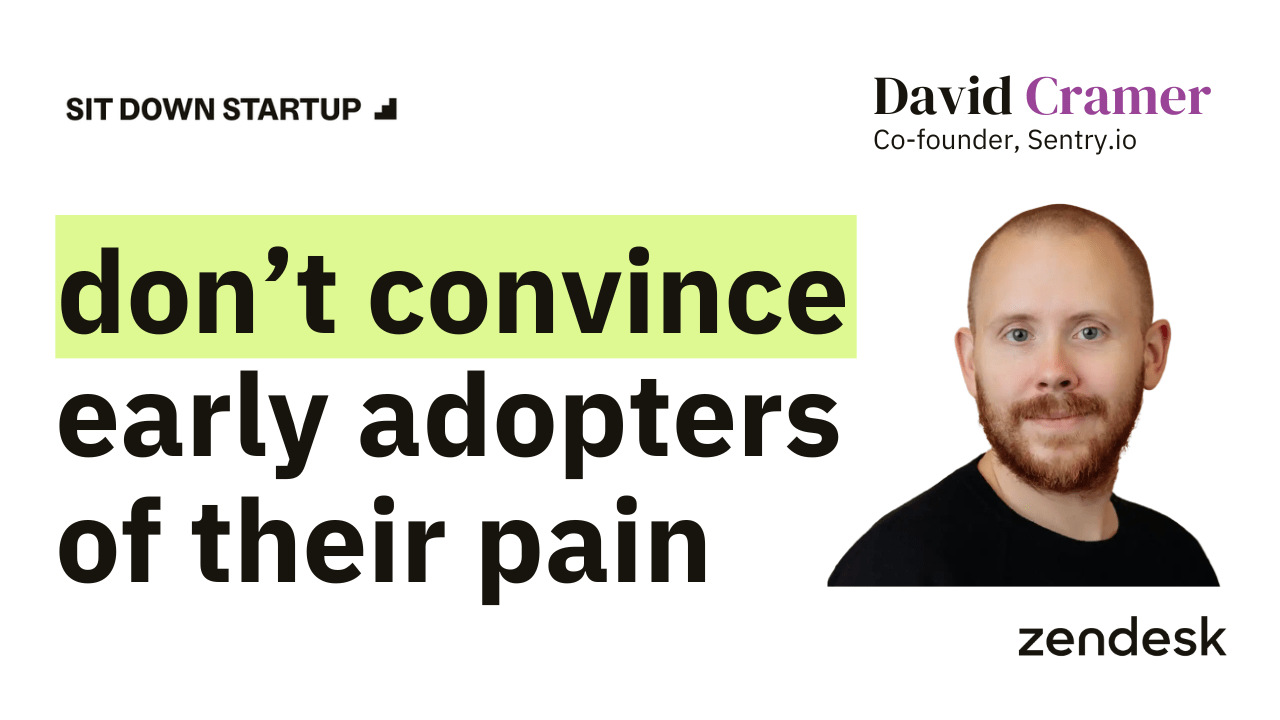Article • 4 min read
Unlocking Sentry's success: Insights from David Cramer's unconventional journey to successfully raising $217 million
The founder shares why it pays to stop convincing prospects and instead focus on finding the ones who inherently understand and appreciate your vision.
출처 Adam O'Donnell, Host of the Sit Down Startup podcast
최종 업데이트: March 13, 2024
In this episode of Sit Down Startup, David Cramer, the founder of Sentry, delves into diverse topics such as unique product monetization, cultivating a strong belief in success, and managing feedback effectively. The conversation also covers customer engagement strategies, including how to differentiate valuable feedback and how focus and determination pave a path to tech success. Cramer stresses the importance of aligning with prospects who share your vision rather than trying to convince everyone of your value.
Cultivate unwavering belief in success by toughing it out and seeing what happens
Sentry was originally a bootstrapped startup. During this time, Cramer and his co-founders supported themselves by working at other companies. By 2015, Sentry had garnered almost 2,000 paying customers and over half a million in revenue. To stay competitive and continue growing, the co-founders decided to fundraise. Because Sentry had existing customers and revenue, they were confident that securing funds would be easy—but they soon found out they were wrong.
VCs declined to invest in Sentry for two reasons: The startup was already making money, and it was not “fashionable” to back at the time. Cramer had meetings with VCs, but he was unable to pique their interest, which was disheartening.
He recalls, “I just remember most of them not even paying attention. These are 15- to 30-minute coffee chats, and they couldn’t hold their attention. But we go through this and it seemed like no one wanted to give us money and I’m like, ‘What are we doing wrong?’’”
Eventually, Cramer secured fundraising from someone he had previously worked with at Dropbox. Although it was difficult, fundraising taught Cramer an important lesson: “You just have to tough it out and see what happens.”
Align with prospects who understand and connect with your vision
There’s a well-worn bit of advice frequently repeated among startup founders: Go to your audience, find out what they want, and build it. Cramer doesn’t endorse this advice. In fact, he thinks it can lead founders in the wrong direction.
He explains, “I don’t think that’s the right way to build a genuine product that’s going to be successful. It’s a great way to build a business, but it’s not a great way to build a change in product or the way people work or a change in technology. The way I think about it is, we had an opinion around how things should be, and we found customers that validated that opinion and we latched on.”
In Cramer’s experience, listening to the wrong audience can leave founders frustrated. For example, two of Sentry’s core tools are crash reporting and error monitoring. Sentry took existing error logs and made them more useful. Although Cramer and his team knew their tools were valuable, potential customers sometimes declined them, stating that they already had logs and didn’t need an improved version, leaving the founders feeling exasperated.
Instead, Cramer advises founders not to waste their time on people who can’t see the value in what they’re doing. “I realized after far too much time that I shouldn’t try to convince people,” he explains. “I should move on to somebody else who believes in what we are doing. And I think the risk for people is, can you find those people? And if you can’t find them, maybe what you’re doing isn’t worthwhile and you should try and do something else. I think that’s a hard conversation for folks… But we’ve got to find the people who want what we have—not try and convince people that what we are building is what we need right now. If it’s useful, when they need it, they will find it.”
Manage feedback at scale
When Cramer was a teenager, he received a bit of advice that has stuck with him since. “I worked at Burger King. I don’t remember what the context was, but at some point, somebody told me, ‘For every customer who complains, there’s nine more that don’t complain.’ So, I love negative feedback. Negative feedback is so clearly transparent in what the problem is and you can synthesize it very easily. I love talking to customers that have complaints because that will give me problems to fix.”
At heart, Cramer is a problem solver. His strength as an engineer boils down to his enthusiasm for identifying and solving bugs. He adopts the same mindset when dealing with customer complaints and wants to hear from anyone who has a suggestion, even as the company grows and acquires thousands of customers. Cramer says, “As you get bigger, it’s hard to keep that feedback pipeline going. … But I am a very big fan of transparent feedback. That’s why I go back to finding the customers that want what you have—they are way more willing to actively give you feedback because they also want to improve it.”
